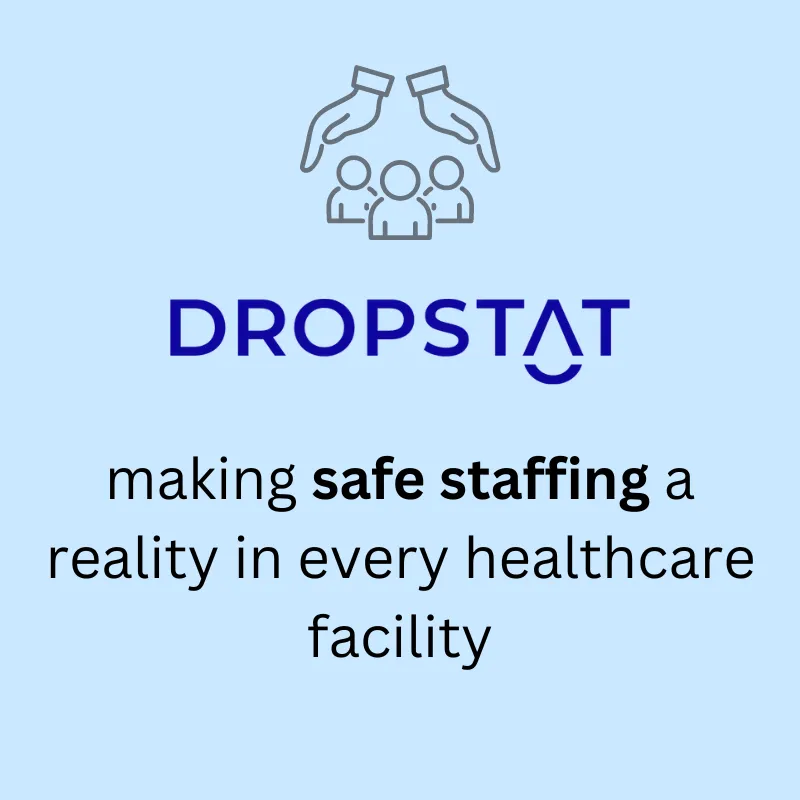What is overtime pay?
Overtime pay in healthcare refers to the additional pay given to employees who work beyond their scheduled hours as set in the Fair Labor Standards Act (FLSA). Employees get overtime pay after working more than 40 hours per week.
Overtime pay is usually one and a half times the employee’s regular pay rate. In other words, for every hour worked beyond the 40-hour weekly threshold (or for hours worked beyond 8 hours in a workday or over 80 hours in 14 days), an employee is entitled to one and a half times their regular pay rate as the overtime premium.
Overtime pay exists to compensate employees for the additional time and effort they put into their work.
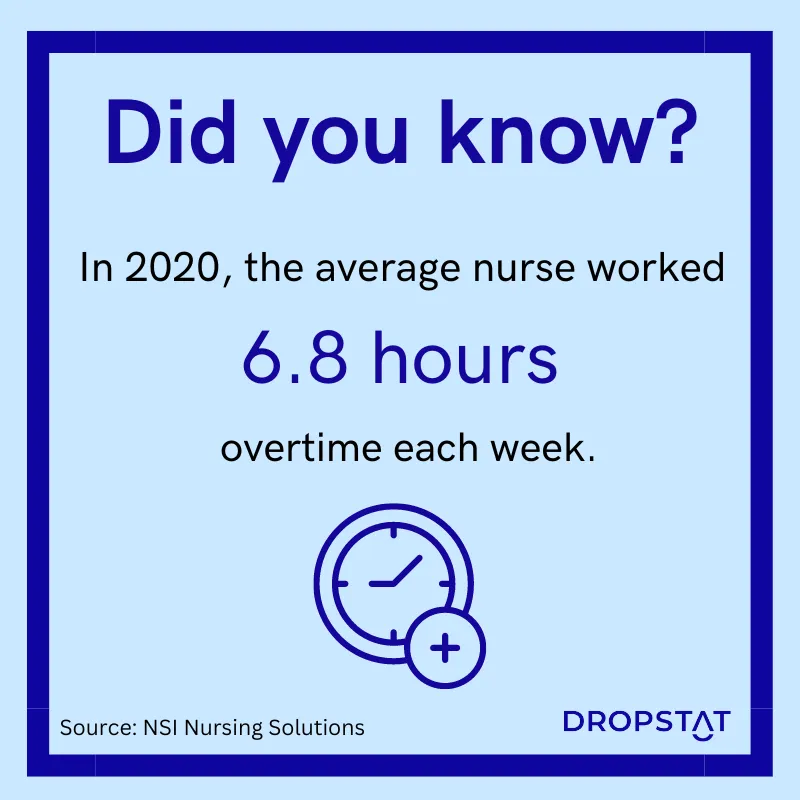
Who is eligible and exempt from overtime pay?
Working over 40 hours in a workweek obligates employers to pay overtime pay, for employees who receive wages on an hourly basis and those paid on a salary basis.
Contingent or temporary workers, such as travel nurses or contract workers, are also eligible for overtime pay if they work 40 hours per workweek and comply with applicable rules.
Not all employees receive overtime pay. Under federal law, executive, administrative, and professional employees are exempt from overtime pay. Exemptions depend on duties, salary level, and other criteria.
Registered nurses (RNs) might be exempt from receiving overtime pay if they are mainly busy with executive or admin tasks. But if they are busy with nursing-related tasks, they are considered non-exempt employees and must be paid overtime as applicable.
Healthcare employers must understand exemptions to ensure that they do not improperly classify their employees as exempt and deny them the overtime pay they are entitled to.

Does an employer have to pay overtime after 40 hours?
Employers are required to pay overtime to eligible workers working more than 40 hours per workweek. If employees are eligible for overtime pay, it is illegal for employers not to pay. Failure to pay overtime can result in legal action and penalties for the employer. Ensure all eligible employees receive the overtime pay they are entitled to.
In addition to legal ramifications, a healthcare facility that does not pay employees overtime pay fairly will achieve a bad reputation and will not be able to attract and retain top employees.
Do different nursing disciplines have different overtime rates?
Nurses of all fields are typically eligible for overtime pay under the FLSA. Nurse overtime pay is an essential issue in the healthcare industry, as nurses often work long hours and may be required to work overtime to provide quality patient care.
There are some circumstances where overtime hours have different rates from the standard. One example is double overtime pay. Some double overtime variations are:
- Double overtime pay is twice the employee’s regular pay rate instead of the one-and-a-half times rate for regular overtime. In Califonia, for example, an employee receives 200% of their regular pay for all hours above 12 hours in one working day or for all hours worked after 8 hours when working seven consecutive days in one workweek.
- Double holiday overtime pay is mandated if, for example, an employee works on a “double holiday” by working overtime on a day when workers also must receive holiday pay. To calculate it: Hourly rate x 300% x overtime hours worked = Double holiday overtime pay.
The rules for all variations of overtime pay can vary by state. It’s important for employers to check their state’s overtime laws to understand when different rates of overtime pay may be required.
How to calculate overtime pay
The actual amount of overtime pay depends on the employee’s regular salary.
Salaried employees: To calculate overtime pay, determine the salaried employee’s hourly pay rate (the weekly or monthly salary divided by the months/weeks and the number of hours worked.) Then you can calculate their overtime rate, which is typically one and a half times their regular pay rate.
Hourly employees: Hourly employees get overtime pay of 1.5 times the normal pay rate for each overtime hour.
Calculate overtime pay by multiplying the overtime rate by the number of overtime hours worked. For example, if an employee’s regular pay rate is $20 per hour, their overtime rate would be $20 x 1.5 = $30 per hour. If they worked 10 hours of overtime, their overtime pay would be $300.
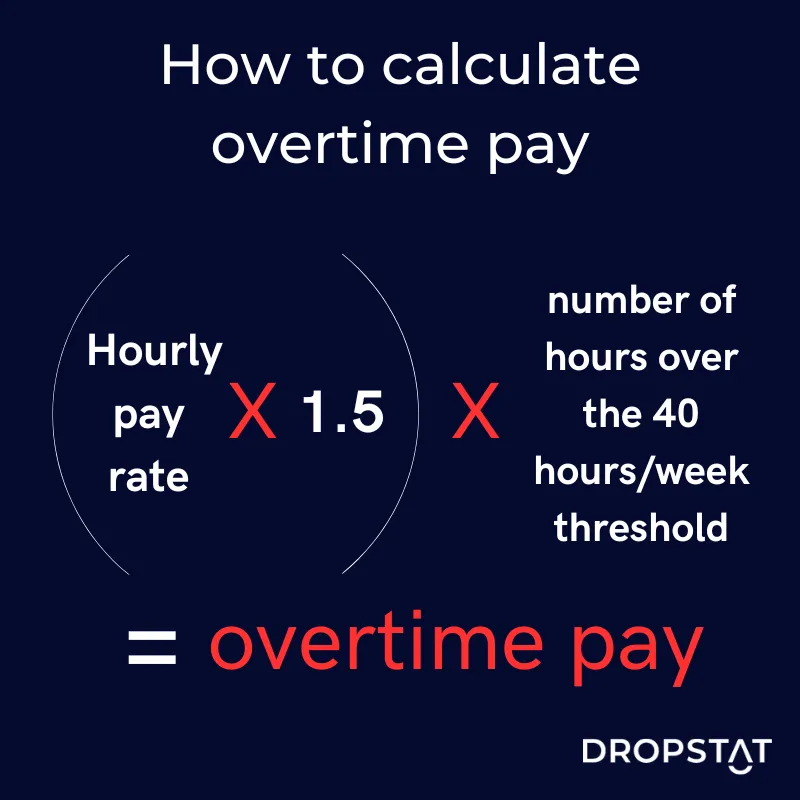
Overtime pay calculators
Calculating overtime pay can be time-consuming. Online overtime pay calculators can be a valuable tool for employers to ensure that they are accurately calculating their employees’ overtime pay. Enter the employee’s regular rate of income and the number of hours they worked beyond the 40-hour threshold. The calculator determines overtime pay based on one-and-a-half times their regular pay rate for every hour of overtime worked.
Dropstat’s work scheduling app integrates with your employee attendance tracker and payroll systems to save effort with an efficient, accurate calculation tool. Dropstat’s pay calculation tool calculates overtime hours for each employee and all shifts and can be programmed to calculate overtime pay according to state-specific laws.
Employers can also see the cost of a shift and specific employees who request or pick up overtime shifts. With an integrated overtime pay calculator, a healthcare facility manager has tighter control over overtime expenses and has a finger on the pulse for potential nurse burnout due to too much overtime work.
The importance of creating an overtime pay policy in healthcare
Employers must make sure that they have an overtime pay policy in place to accurately calculate their employees’ overtime pay and pay them the additional overtime compensation that they are entitled to under federal and state laws.
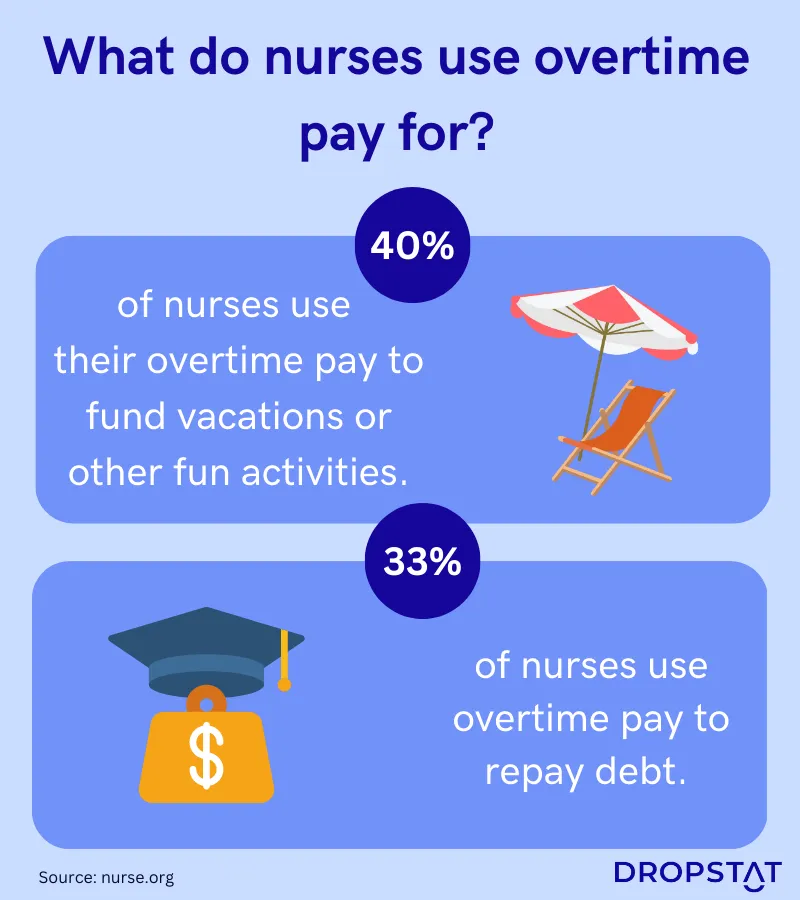
How to create an effective overtime pay policy
Creating an overtime pay policy involves several steps to ensure fairness, compliance with labor laws, and that it meets the needs of the company and employees. Here are the steps to creating an overtime pay policy:
Determine the applicable labor laws: The first step is determining the labor laws that apply to your organization.
Define overtime: Define what qualifies as overtime in your facility, such as working beyond a certain number of hours per week or workday. The overtime mechanism can vary depending on the nursing discipline.
Set the overtime pay rate: Determine the overtime pay rate. Some facilities pay more for overtime hours on weekends or holidays.
Establish eligibility: Determine which employees are eligible for overtime pay. Employees such as executives and managers are exempt.
Establish a record-keeping system: Set up a system to track all hours worked, including overtime hours.
Communicate the policy: Clearly communicate the overtime pay policy to employees. Explain how overtime is calculated, caps on how many overtime hours employees may work, and any requirements.
Train supervisors: Train nurse managers and schedulers on the overtime pay policy so they can answer questions from nurses.
Apply policy in practice: Use up-to-date digital tools for calculating wages and overtime amounts. Pay attention to where overtime pay is due and why.
Monitor compliance: Monitor compliance with the overtime pay policy. Address any issues promptly.
When creating an overtime pay policy, it is advisable to consult with legal counsel to ensure compliance with laws and regulations. A good way to stay up-to-date on overtime pay trends and regulations is by attending webinars, conferences, and local relevant events.
Tips to help healthcare facilities avoid overtime pay
Here are some practical tips to help managers use facility resources cost-efficiently and avoid paying overtime:
- Awareness: Track work hours with a system that highlights nurses who go into overtime.
- Cross-train employees: Cross-training provides a pool of skilled employees to fill shift gaps. You won’t be forced to pay expensive nurse overtime because of an insufficient supply of skills.
- Communicate: Clearly express the facility’s overtime expectations to nurse managers.
- Plan ahead: Set predictable and realistic employee schedules as early in advance as possible, taking into account patient volume trends. Effective staff planning and gap-shift filling with cost-effective staff will help the facility avoid paying overtime.
- Hire enough permanent staff: If a shift constantly goes into overtime, consider hiring more permanent staff and avoid overtime premiums.
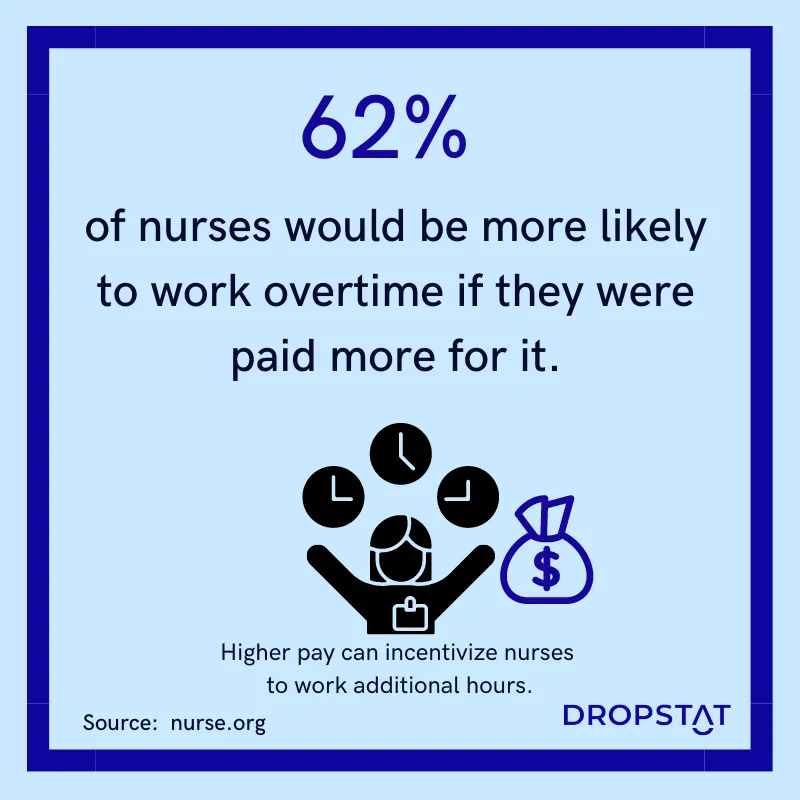
How Dropstat can help healthcare facilities save on overtime pay and fill shifts more cost-efficiently
Dropstat is a state-of-the-art AI-driven scheduling app for healthcare facilities. Its advanced algorithms can help save paying expensive overtime rates while still complying with HPPD regulations.
Dropstat clearly lays out nurse schedules for every department up to 2 months in advance. For all understaffed shifts, schedulers send out shift requests to an internal team of staff with the skill set required. Nurses have the option to pick up and request open shifts. Dropstat flags nurses who will be going into overtime by picking up a shift. The app also alerts the scheduler as to how much each shift that uses staff who are working overtime will cost the facility. In most cases, schedulers will be able to reject nurses applying for overtime shifts and approve nurses who are more cost-effective for the facility.
Dropstat also uses data analytics to show facility managers which shifts are constantly filled with overtime or agency staff. Dropstat can recommend hiring more permanent staff from the right nursing discipline to fill those shifts instead of resorting to expensive overtime.
By reducing overtime, you aren’t just lowering costs; you are also preventing the toxic burn and churn cycle. Schedule a demo to see how Dropstat can help fill shifts effectively while avoiding overtime pay.
A Dropstat case study
A multi-location healthcare facility began working with Dropstat in 2021. After implementing Dropstat’s employee cost tagging and overtime tagging features, they found that one location had spent over $19,000 a month in overtime pay, which could have been avoided by effective staff planning.
By using Dropstat’s advanced scheduling system, apart from fully staffing each shift and reaching safe staffing ratios, they had saved a huge $225,00 in one year! Of this sum, over $218,000 would have been paid in overtime to stressed and overworked staff. Instead, the facility began to run a less stressful work environment and was able to provide quality patient care in a more financially efficient way.
